- Places
- Plans
- Itineraries
- Experiences
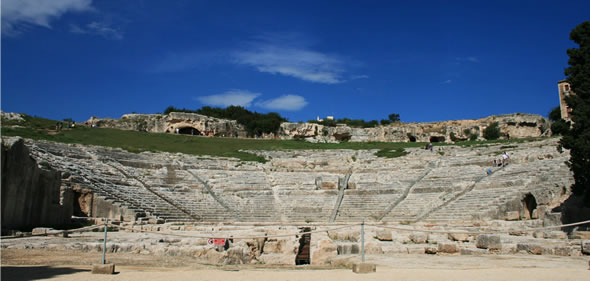
The Greek Theater. (Photo by Claus Moser)
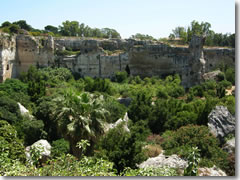
The Latomia del Paradiso (Photo by Sailko)This vast archaeological park contains Siracusa's greatest concentration of ruins.
It's divided into three main sections: the latomie (stone quarries), the Greek theater, and the Roman amphitheater, all of which you can see in about two hours.
The first two (latomie and Greek theater) are together beyond the main gate. Hold on to your ticket, for upon exiting the Greek theater/latomie area you backtrack up the souvenir stand–lined road to enter the Roman amphitheater area.

The Orecchio di Dioniso, or Ear of Dionysius. (Photo by Sailko)After the ticket desk, veer right onto the path down to the Latomia del Paradiso, an ancient quarry now planted with a jungle of orange and lemon trees.
In the back wall is a narrow cavern 76 feet high, 214 feet deep, and only about 25 feet wide.
It was dubbed by Caravaggio the "Ear of Dionysius"—either due to its pointy shape, like the ear on a satyr, or its remarkable acoustics, allowing you to stand at one end and hear a whisper spoken at the other.
Dionysius' name enters the picture from a local legend that this ancient tyrant used this cave as a prison and its acoustics to spy on his captives. Not that Dionysius was a tyrant or anything. "Tyrant" was actually the official name of the ruler of Syracuse in that era—like saying "king" or "president" or "governor." That isn't to say he wasn't above playing hardball politics; just that he wasn't tyrannical in the modern meaning of the word. (Oh, and aside from similar-sounding names, he had nothing to do with the Roman god of wine, either—that "Dionysus.")
Next door to the "ear" is the pretty Grotta dei Cordari ("ropemaker's cave"), a wide quarry fissure romantically filled with water and maidenhead ferns. Its preservation is in a precarious state, so it has been roped off for years. Pity.
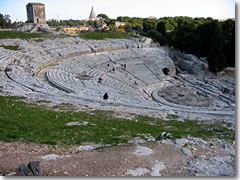
The Greek Theater. (Photo by Victoria)Return to the ticket office and take the left path, which leads to the stark white curve of seats comprising the Greek theater, one of the largest in the world at 455 feet in diameter.
Built in the 5th century BC and later expanded, its 42 rows of seats were hewn directly out of the living rock, and probably saw the first productions of some of Aeschylus' plays.
The Romans, who felt serious drama was to be taken only in moderation, adapted the thing so they could occasionally flood the stage and stage tiny mock sea battles.
They still use the theater for summertime productions (mostly classical plays)—wonderful if you can attend one, but the modern stage and fill-in-the-gap aluminum grandstand seating they erect during the season kind of spoils the antique mood for daytime sightseers.
At the top of the cavea are niches that once contained little votive altars, plus a little niched pond that collects the cold water flowing from an ancient aqueduct—great for dipping your tired feet.
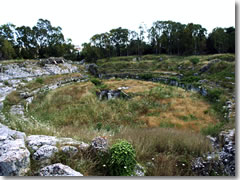
The Roman Amphitheatre. (Photo by Giovanni Dall'Orto)On the path down into the Roman amphitheater area you'll see on your left the few columns still standing and the long stone base of the 3rd-century BC Altar of Hieron II, at 653 by 75 feet, the longest altar ever built.
The AD 1st-century Roman amphitheater, was where Siracusans held bloody gladiator fights and the like when they tired of the plays at the Greek theater.
It, too, is used today for productions (mainly musical) in the summer, when bright red poppies bloom against the green wash of the overgrown seating sections.
★★ Area Archeologica della Neapolis, Orecchio di Dionisio e Teatro Greco
Via Paradiso 14/Largo Anfiteatro, off Corso Gelone/Viale Teracati (Via del Teatro Greco)
tel. +39-0931-66-206 or +39-0931-65-068
www.regione.sicilia.it/beniculturali
Open daily 9am–6pm (closes to tourists at 4:30pm during days of performances)
Adm: €10
Bus there: From Ortigia: 1, 3, 11, 12, 18, 25, 30; From the train station: 21, 22, 23, 27, Navetta Cimitero.
Bus
back to Ortigia: 4, 5, 8, 11, 12, 26
Expect to spend a minimum of two hours here. There's plenty of walking from place to place, and it takes a while to explore each one.
There are various cumulative tickets you can get that cover admission (at a savings) to the Neapolis archaeological park plus either the Paolo Orsi Archaeological Museum, the Galleria Bellomo, the Villa Tellaro, or all four of them.
The city sponsors summertime events held in the ancient Greek theater. These tend to be of classical plays translated into Italian—some of which even premiered in this very theater... 2,500 years ago). Contact the tourist office for specifics.
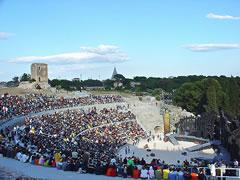
A performance at the Greek Theater. (Photo by digitaluke)
Because Siracusa buses follow circular routes (rather than out and back), you have to take one bus there (well, one of several choices), but a different bus back.
Share this page
Search ReidsItaly.com
★★ Area Archeologica della Neapolis, Orecchio di Dionisio e Teatro Greco
Via Paradiso 14/Largo Anfiteatro, off Corso Gelone/Viale Teracati (Via del Teatro Greco)
tel. +39-0931-66-206 or +39-0931-65-068
www.regione.sicilia.it/beniculturali
Open daily 9am–6pm (closes to tourists at 4:30pm during days of performances)
Adm: €10
Bus there: From Ortigia: 1, 3, 11, 12, 18, 25, 30; From the train station: 21, 22, 23, 27, Navetta Cimitero.
Bus
back to Ortigia: 4, 5, 8, 11, 12, 26